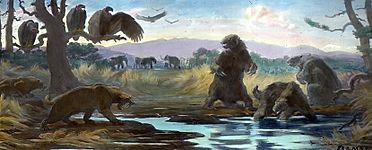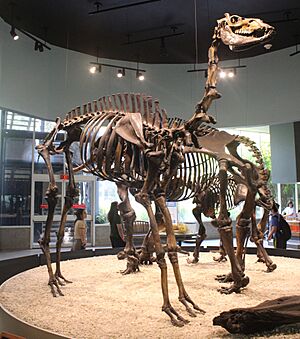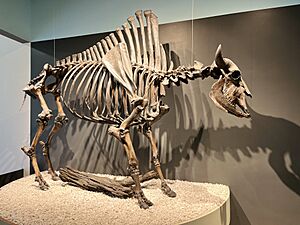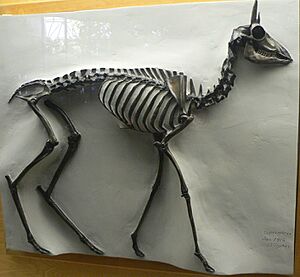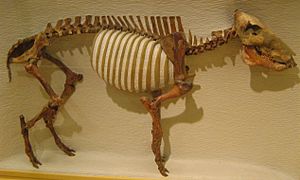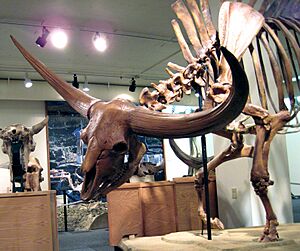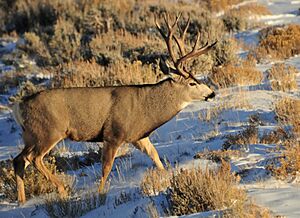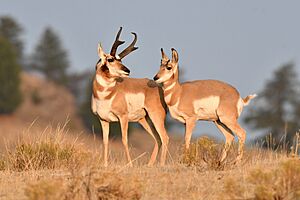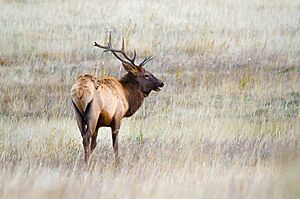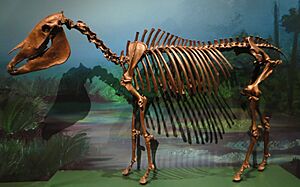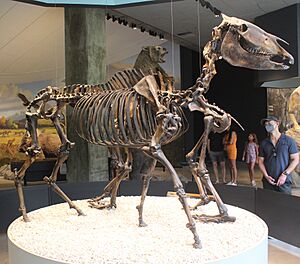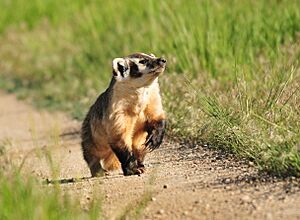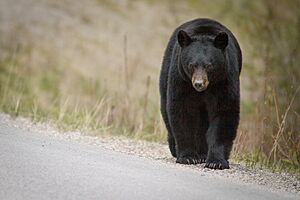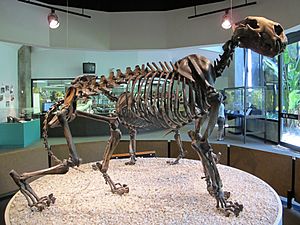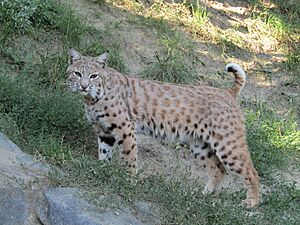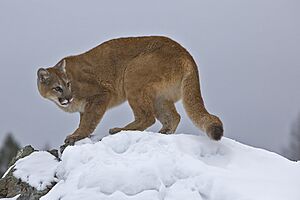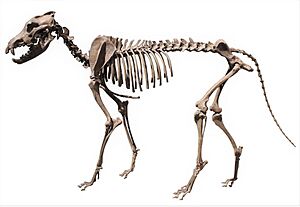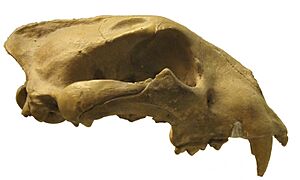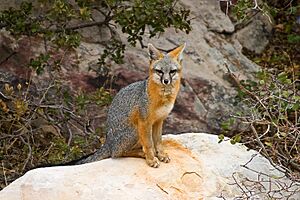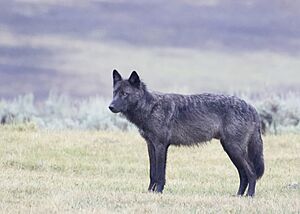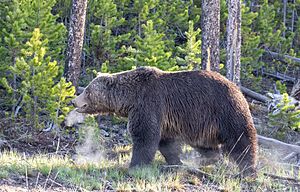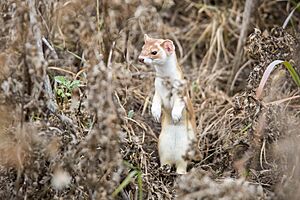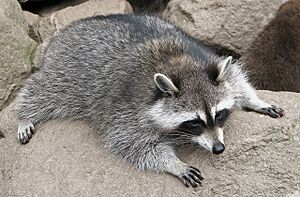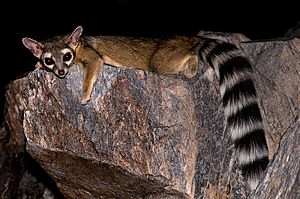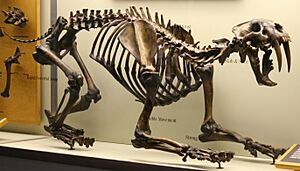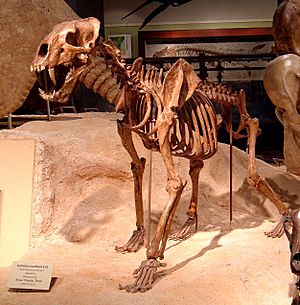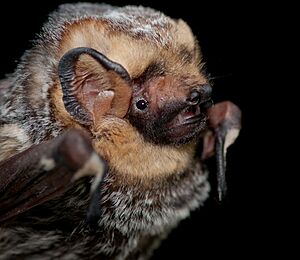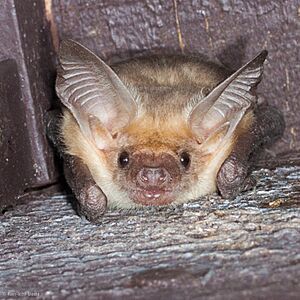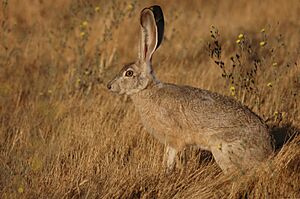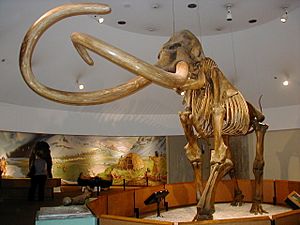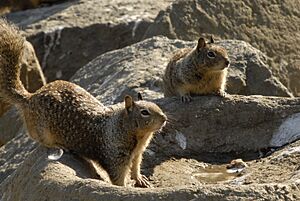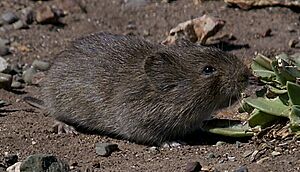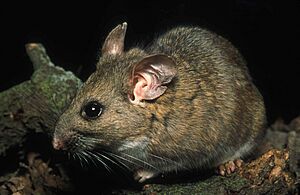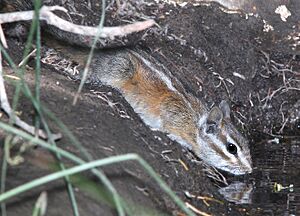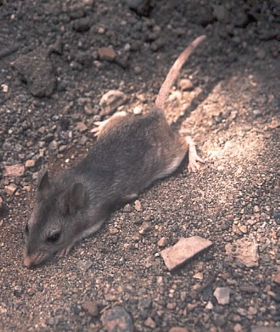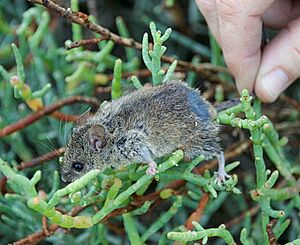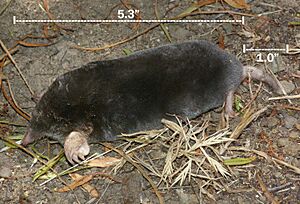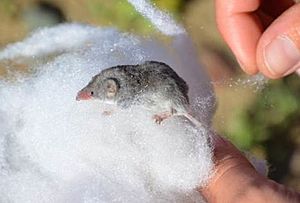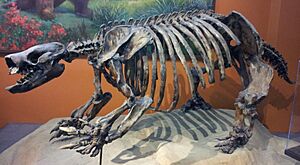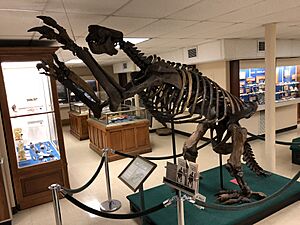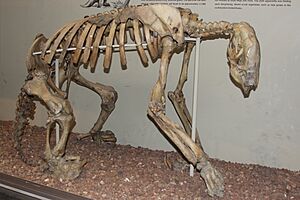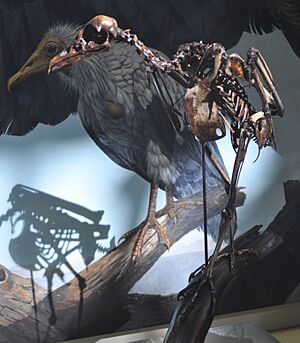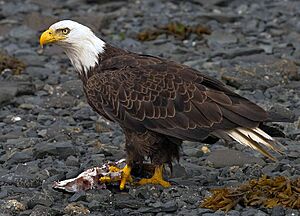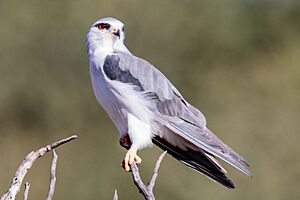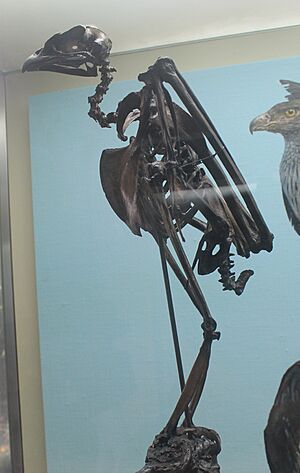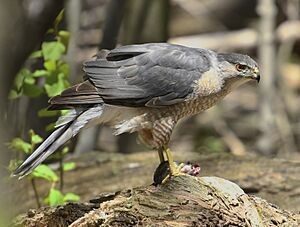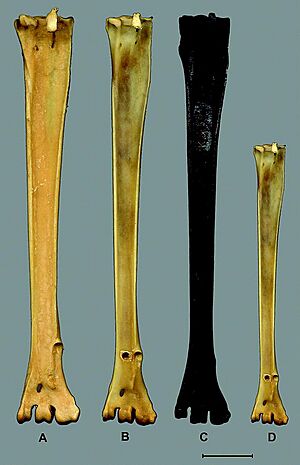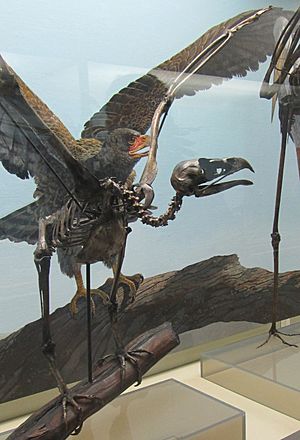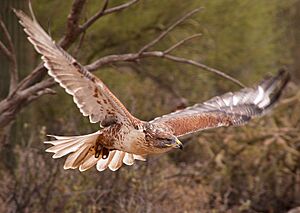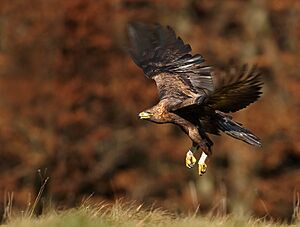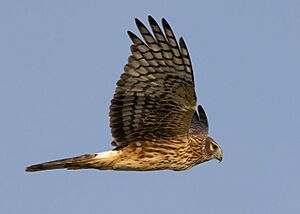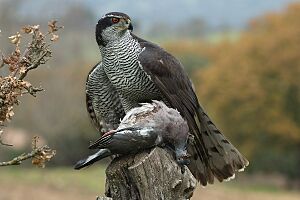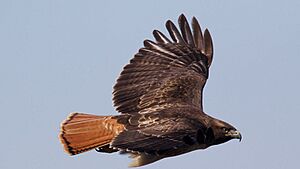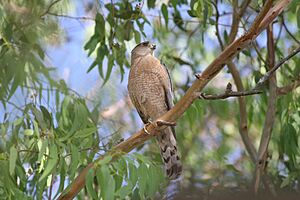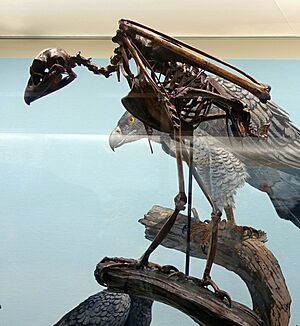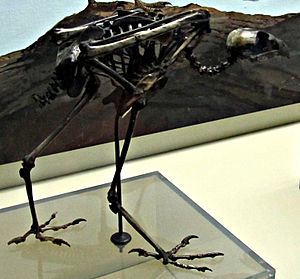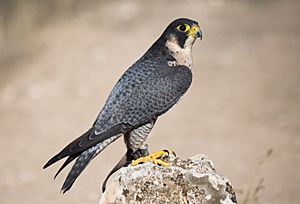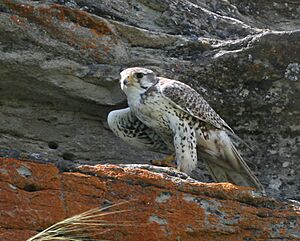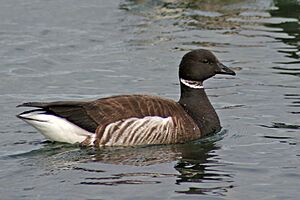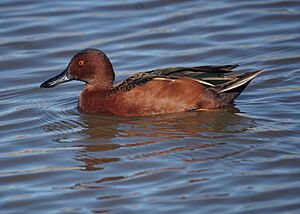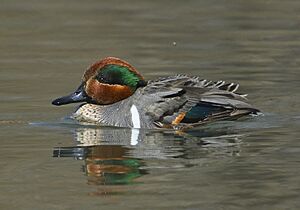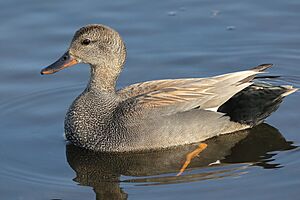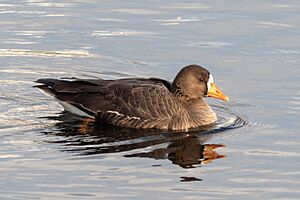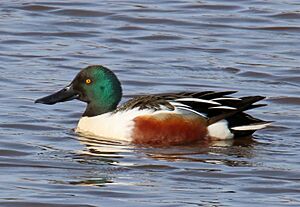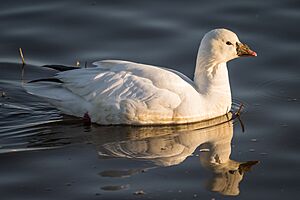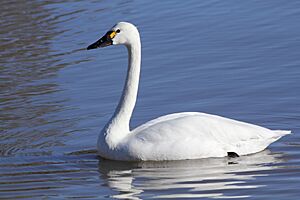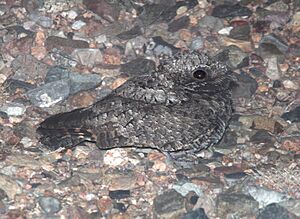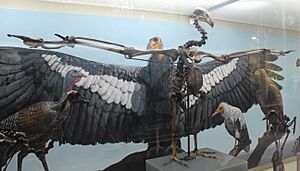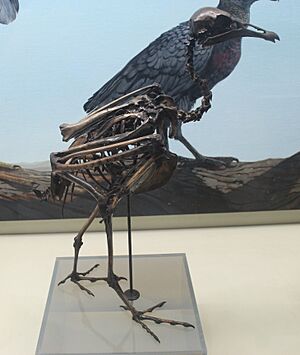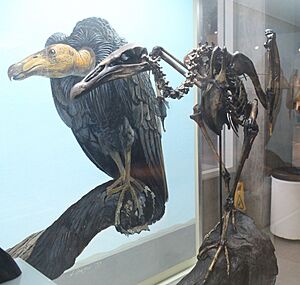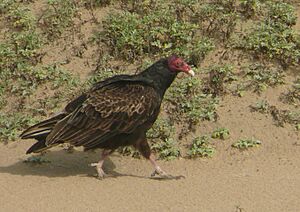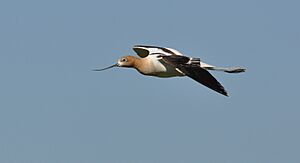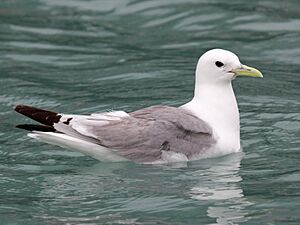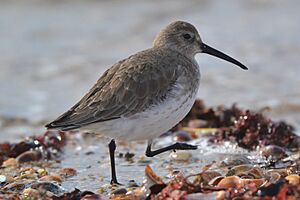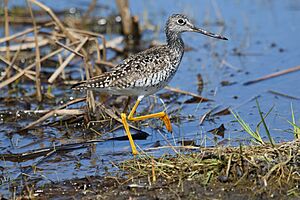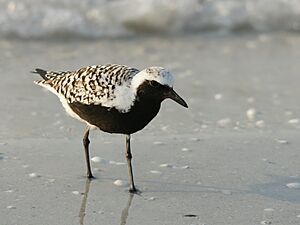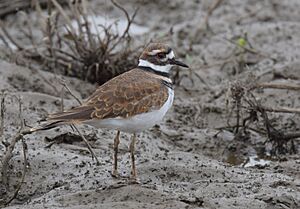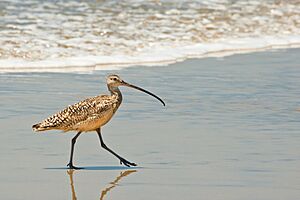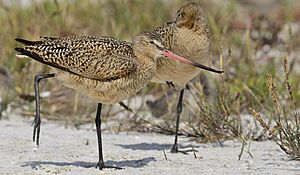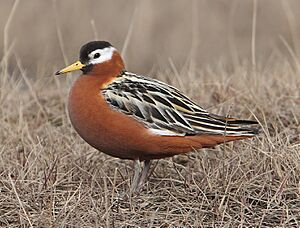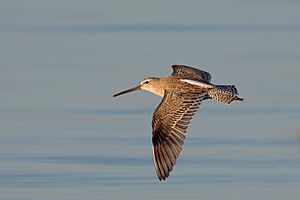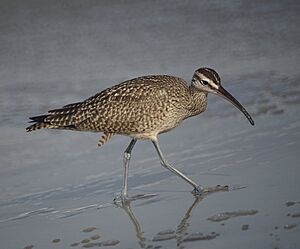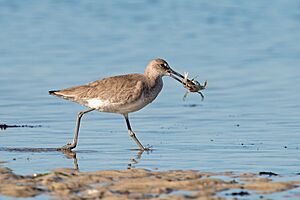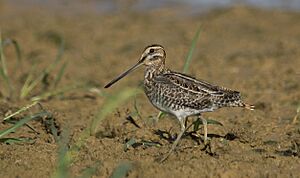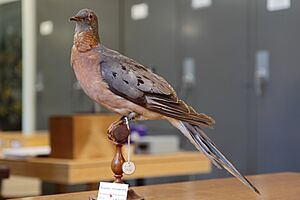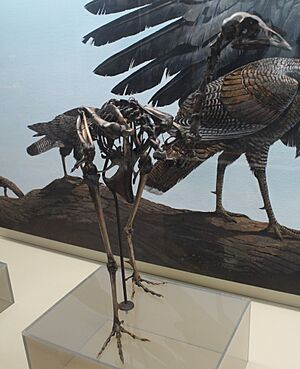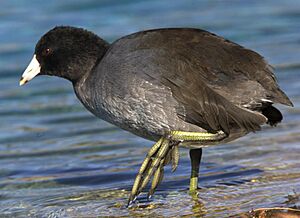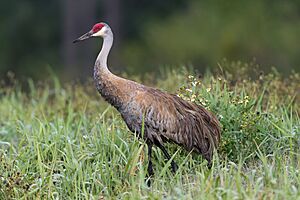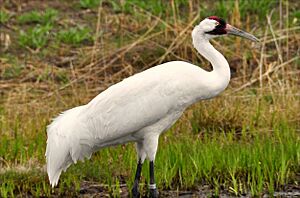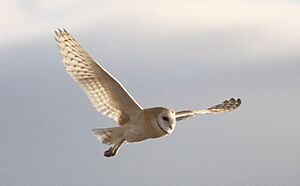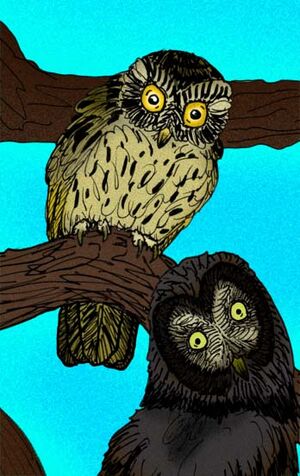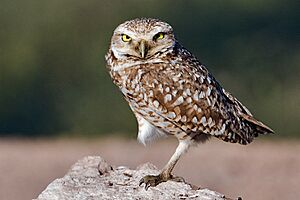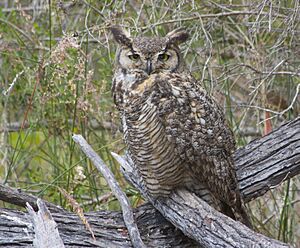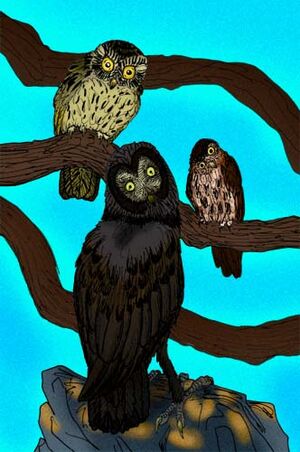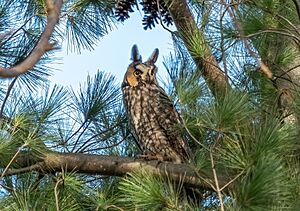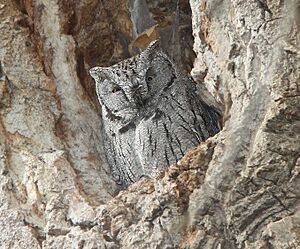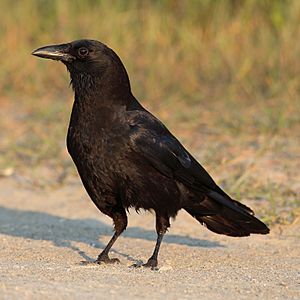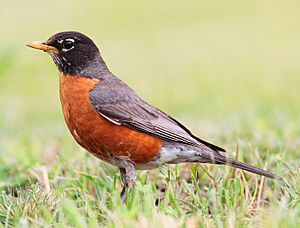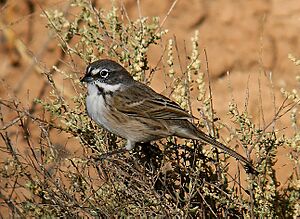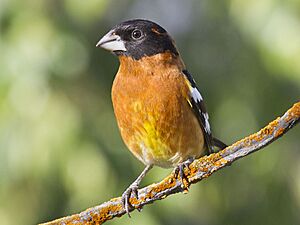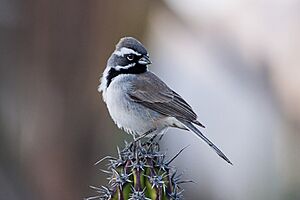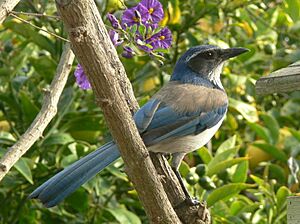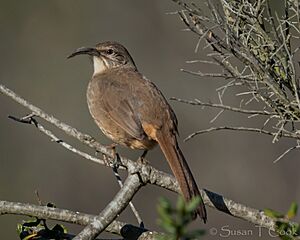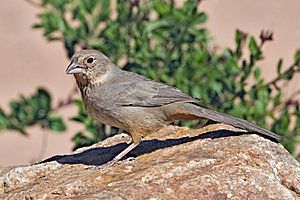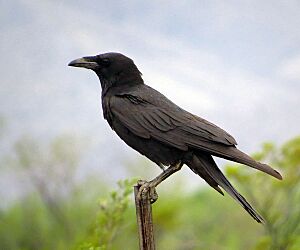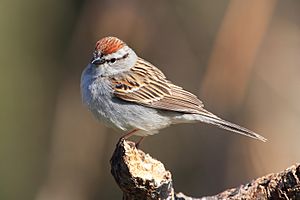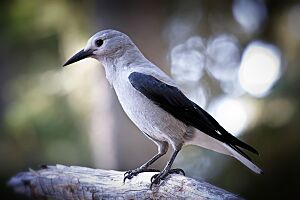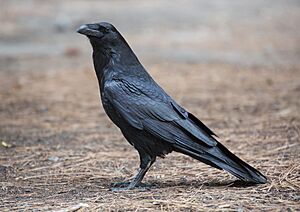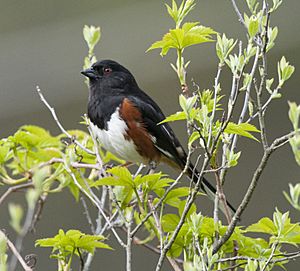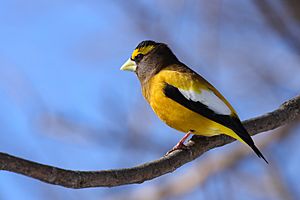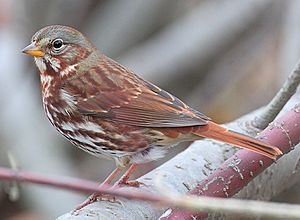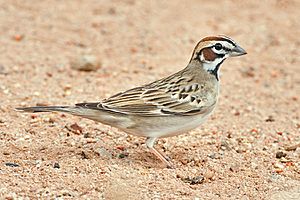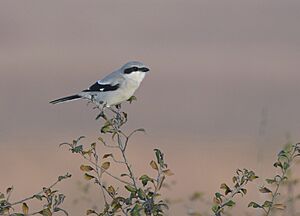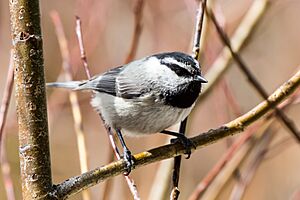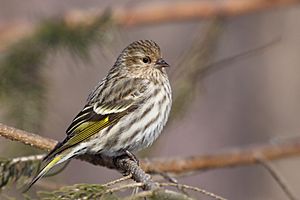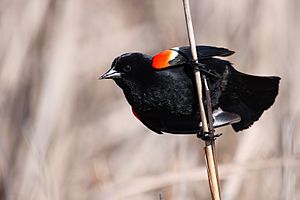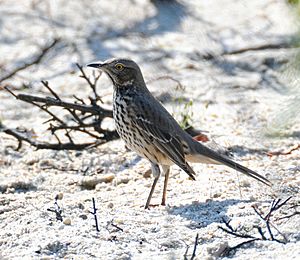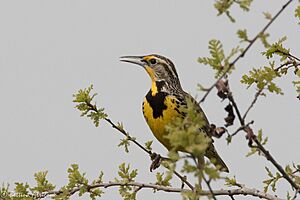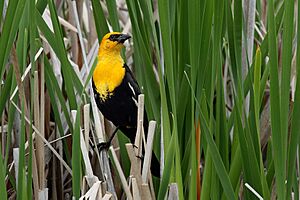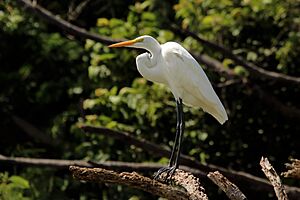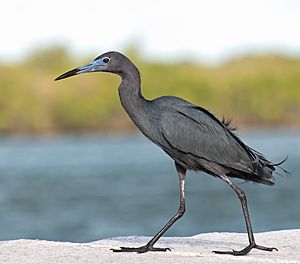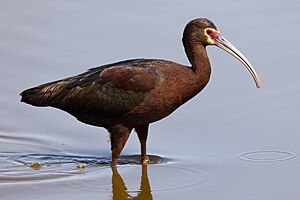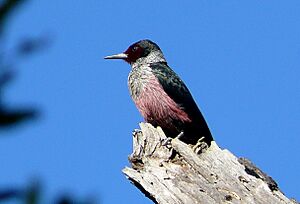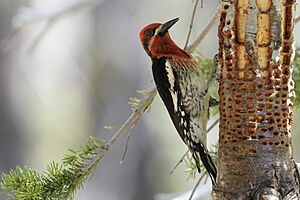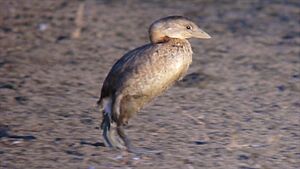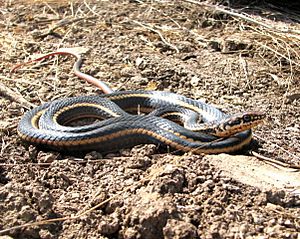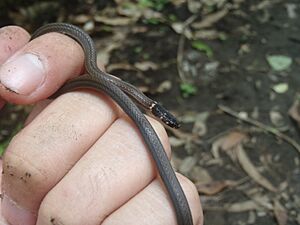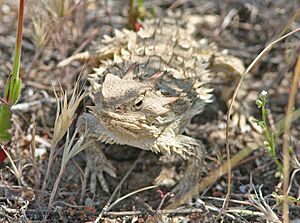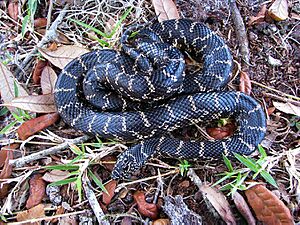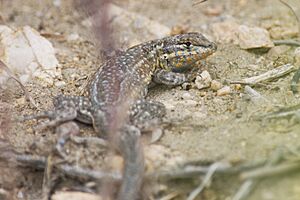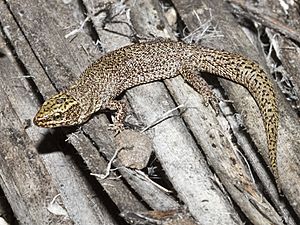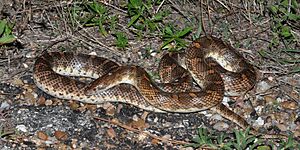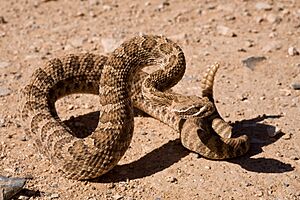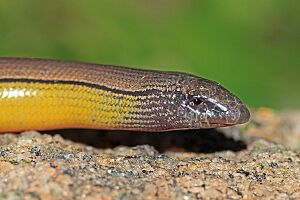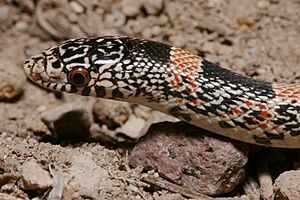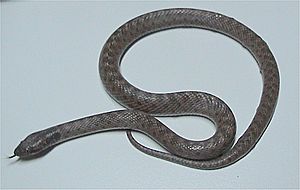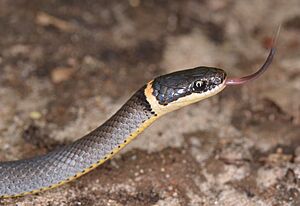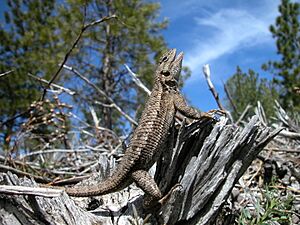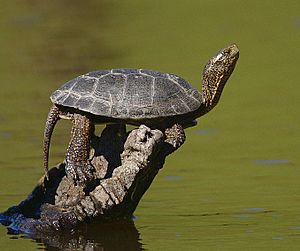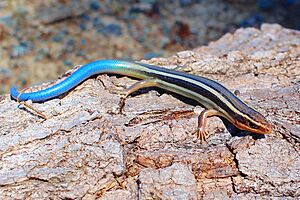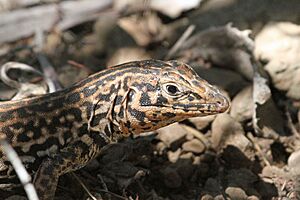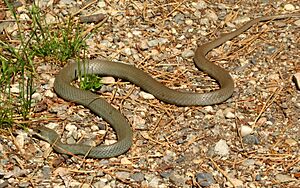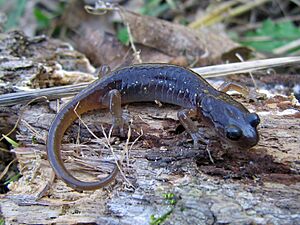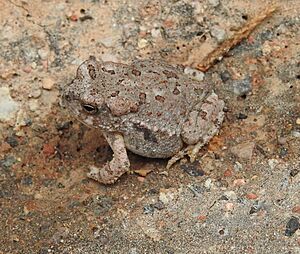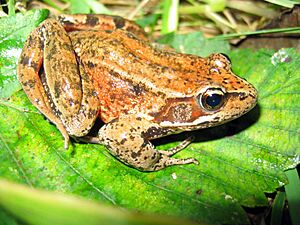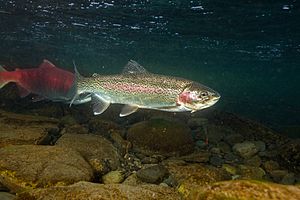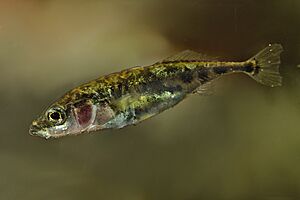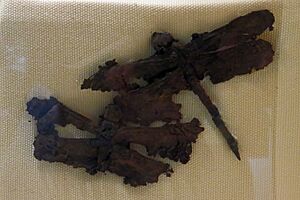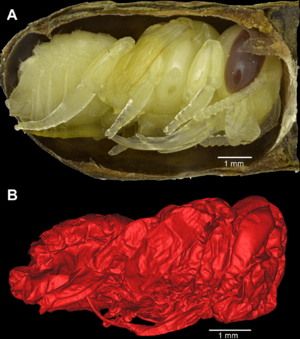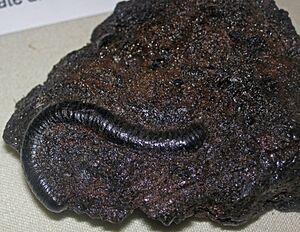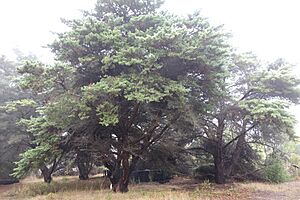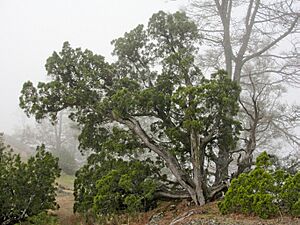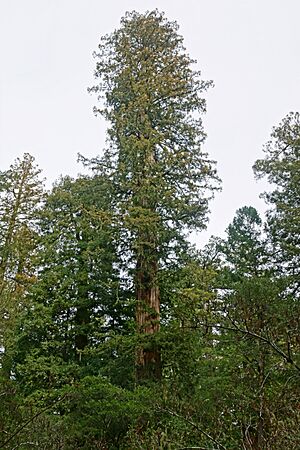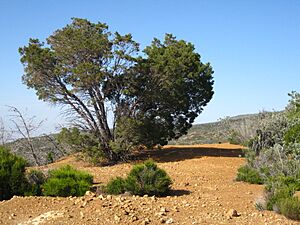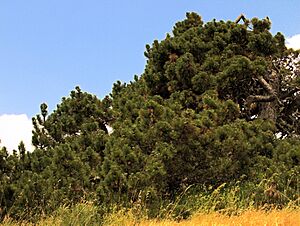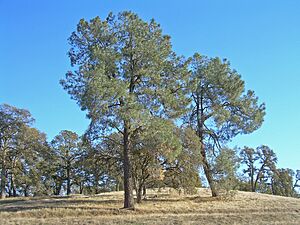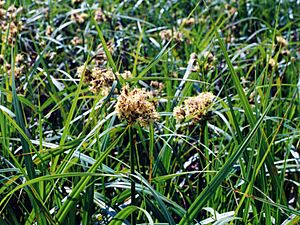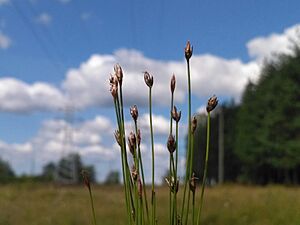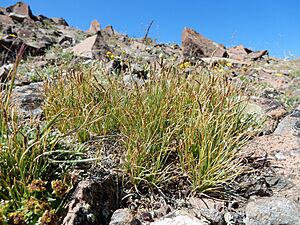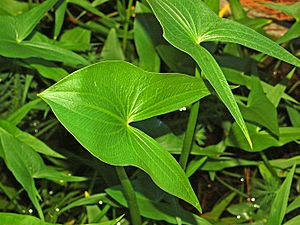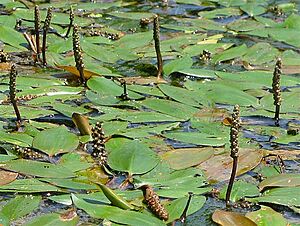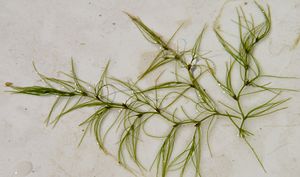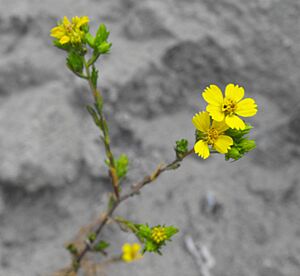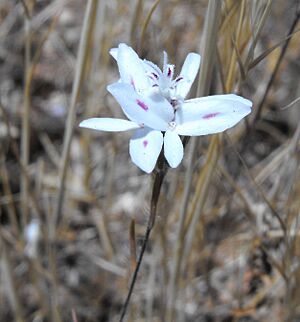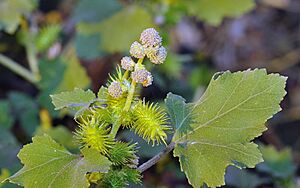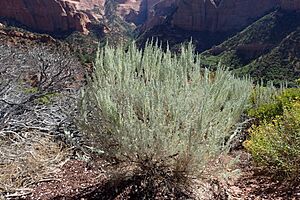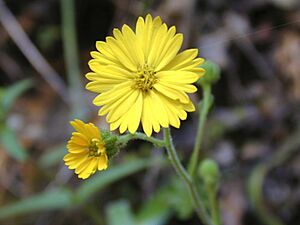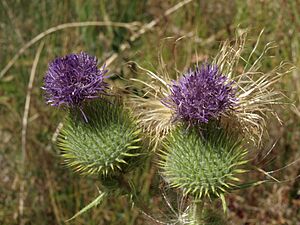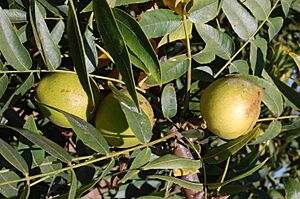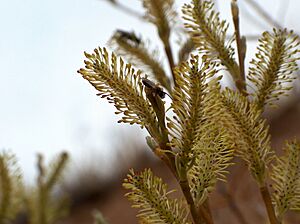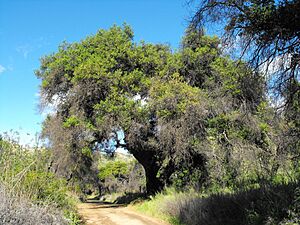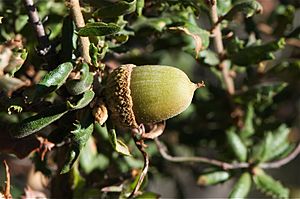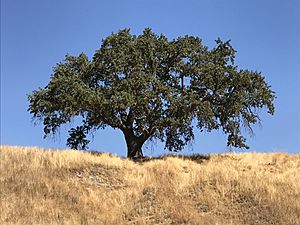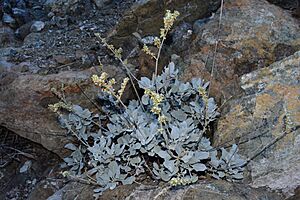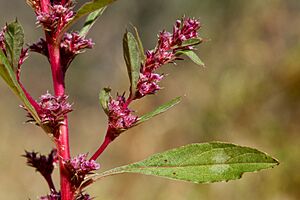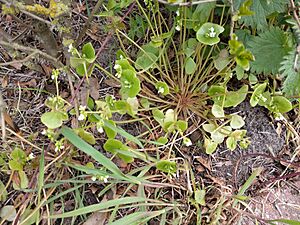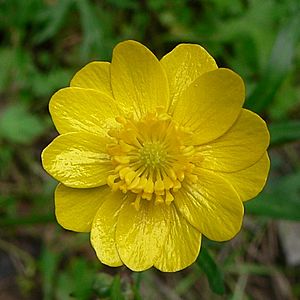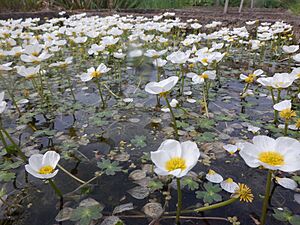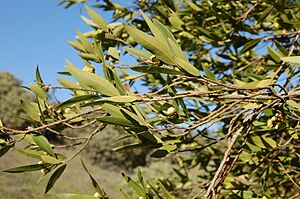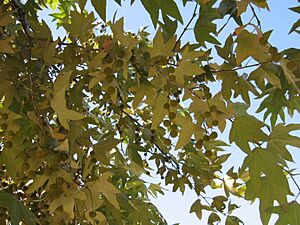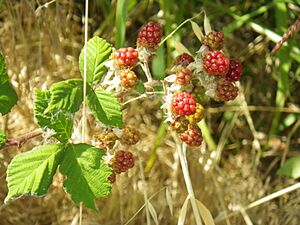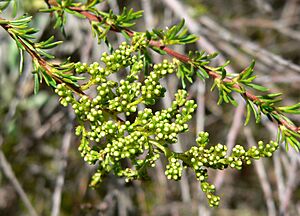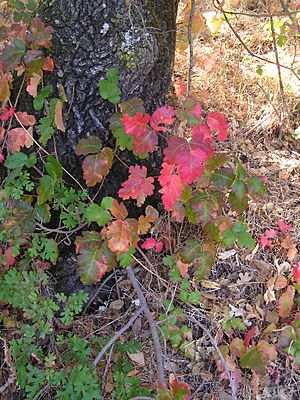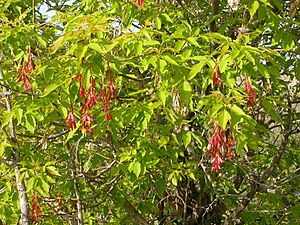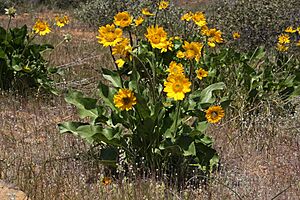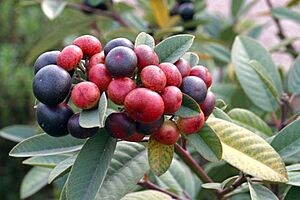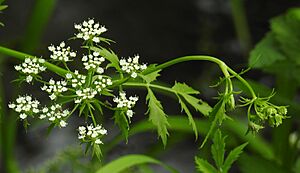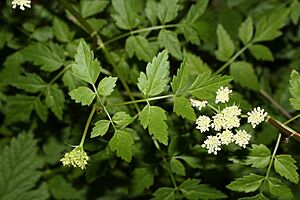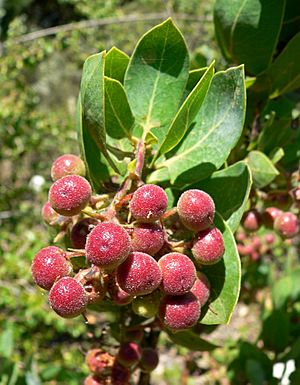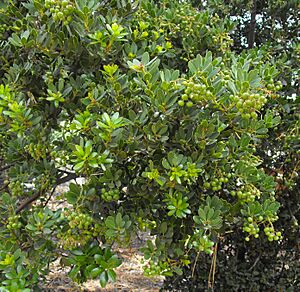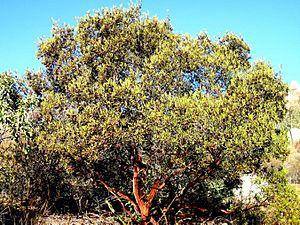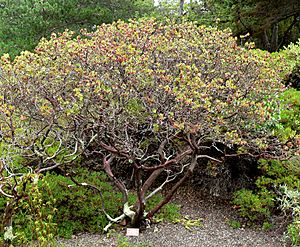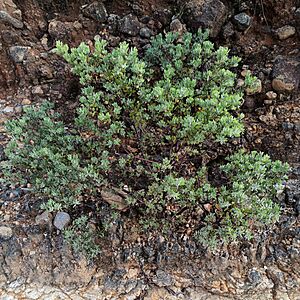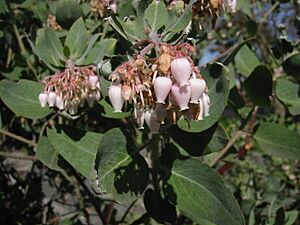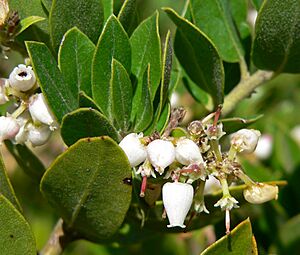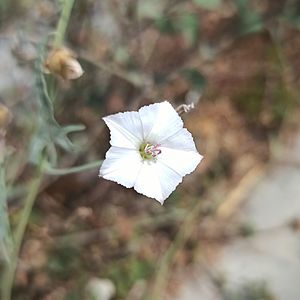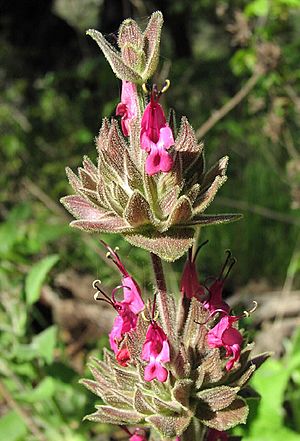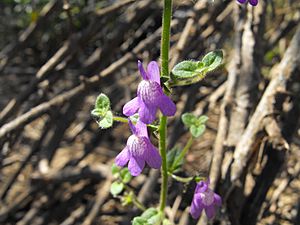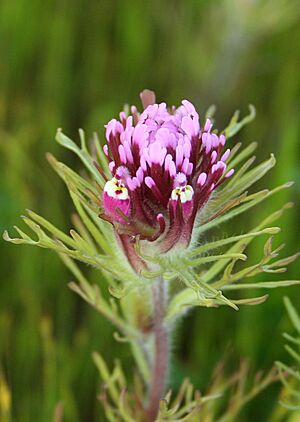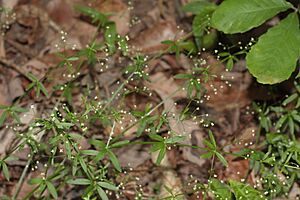Paleobiota of the La Brea Tar Pits facts for kids
Imagine a sticky, gooey trap that has been catching animals for thousands of years! That's what the La Brea Tar Pits are like. Located in Los Angeles, California, these natural tar (or asphalt) seeps have preserved an amazing collection of ancient plants and animals.
Many of the fossils found here are on display at the adjacent George C. Page Museum of La Brea Discoveries in the park. Most of these fossils are from the Pleistocene Ice Age, which was a time of giant mammals. The daggers (†) next to a name mean the species is now extinct, meaning it no longer exists on Earth.
Ancient Mammals
The La Brea Tar Pits are famous for their incredible collection of Ice Age mammals. Many large predators got stuck here, probably while trying to hunt other animals that were already trapped.
Hoofed Animals
These are animals like camels, bison, and horses that have hooves.
- † Western Camel (Camelops hesternus)
- These large camels were common in the tar pits. They ate a variety of plants. Along with ancient bison and horses, they are some of the most common plant-eaters found here.
- † Ancient Bison (Bison antiquus)
- Over 300 ancient bison fossils have been found! These huge bison were likely ancestors of today's American bison. They are the most common large plant-eater at La Brea.
- † Dwarf Pronghorn (Capromeryx minor)
- This tiny pronghorn was less than half the size of modern pronghorns. It had unique, simple horns.
- † Flat-headed Peccary (Platygonus compressus)
- This pig-like animal lived in grasslands and dry areas. It was good at eating grasses.
- † Giant Bison (Bison latifrons)
- One of the biggest hoofed animals ever, the giant bison had very long horns. It was probably an ancestor of the ancient bison.
- Mule Deer (Odocoileus cf. hemionus)
- Deer remains found here might be from the modern mule deer.
- Pronghorn (Antilocapra americana)
- This species is a larger relative of the dwarf pronghorn. The fossils are just like modern pronghorns.
- Wapiti (Cervus cf. canadensis)
- Also known as elk, their fossils haven't been dated, so we don't know if they lived with other famous La Brea animals.
- † Shrub-ox (Euceratherium cf. collinum)
- An extinct relative of the modern muskox. It ate trees and shrubs.
- † Large-headed Llama (Hemiauchenia macrocephala)
- This llama species ate whatever food was available.
- † California Tapir (Tapirus californicus)
- A small tapir species, not many of its fossils have been found at La Brea.
- † Mexican Horse (Equus conversidens)
- A small horse species, only a few remains have been found.
- † Western Horse (Equus occidentalis)
- Over 200 western horse fossils have been found, making it one of the most common plant-eaters. Their teeth suggest they ate a mix of grasses and woody plants.
Meat-Eating Mammals
The tar pits are especially famous for their many predator fossils.
- American Badger (Taxidea taxus)
- Badger fossils are also found here. Some might have gotten trapped when tar seeped into their burrows.
- American Black Bear (Ursus americanus)
- Ancient black bears were larger than today's. They are not as common in the tar pits, possibly because their varied diet made them less likely to scavenge and get stuck.
- † American Lion (Panthera atrox)
- These huge cats were even bigger than modern lions. At least 80 individuals have been found. They might have come from Eurasian cave lions.
- Bobcat (Lynx rufus)
- Bobcats are rare compared to other cats at La Brea.
- Cougar (Puma concolor)
- Cougars at La Brea hunted prey in wooded areas. They had a more varied diet than saber-toothed cats or American lions, which might be why they survived to modern times.
- † Dire Wolf (Aenocyon dirus)
- The dire wolf was the most common predator found at La Brea, with over 4,000 individuals! They were larger than modern gray wolves. Despite their name, this animal is not a true wolf.
- Domestic Dog (Canis familiaris)
- Several dog fossils have been found. One small dog was similar to the Techichi breed. These dog remains are much younger than the human remains found nearby.
- † Giant Jaguar (Panthera onca augusta)
- This was a giant subspecies of the modern jaguar. Fossils range from 11,600 to 28,000 years old.
- † Giant Short-faced Bear (Arctodus simus)
- One of the largest meat-eating mammals ever, these bears weighed around 600 kg (1,300 lbs). Studies suggest they were omnivores, eating both plants and meat, much like many modern bears.
- Gray Fox (Urocyon cinereoargenteus)
- Gray fox remains make up a small part of the predator fossils.
- Gray Wolf (Canis lupus)
- Modern wolves are much rarer than dire wolves at La Brea. One fossil shows a wolf that survived a serious leg injury.
- Grizzly Bear (Ursus arctos horribilis)
- A complete grizzly bear skull was found in Pit 10. These bears appeared in La Brea after the larger short-faced bears went extinct.
- Long-tailed Weasel (Neogale frenata)
- These weasels ate ground squirrels and rabbits. They are the most common weasel-like animal found at La Brea.
- † Pleistocene Coyote (Canis latrans orcutti)
- These ancient coyotes were bigger and stronger than today's coyotes. They actively hunted larger prey. They are the third most common predator found in the tar pits.
- Raccoon (Procyon lotor)
- Only one raccoon fossil has been found. Raccoons are nocturnal, meaning they are active at night when the tar is cooler and less sticky, making them less likely to get trapped.
- Ringtail (Bassariscus astutus)
- Only one ringtail fossil has been found, possibly for the same reasons as raccoons.
- † Saber-toothed Cat (Smilodon fatalis)
- Over 2,000 saber-toothed cat individuals have been found, making them the second most common carnivore. They had huge, dagger-like teeth. They likely hunted large animals.
- † Scimitar-toothed Cat (Homotherium serum)
- This cat was much rarer than the saber-toothed cat. It was a fast hunter that preferred open areas and ate grazing animals, including young mammoths.
- Striped Skunk (Mephitis mephitis)
- Striped skunks make up almost 1% of the carnivore fossils.
- Western Spotted Skunk (Spilogale gracilis)
- These skunks are rarer than striped skunks in the tar pits.
Bats
- Hoary Bat (Lasiurus cinereus)
- Remains of the hoary bat were found in Pit 91.
- Pallid Bat (Antrozous pallidus)
- Pallid bats might have gotten stuck in tar because they hunt insects close to the ground.
Rabbits and Hares
- Black-tailed Jackrabbit (Lepus californicus)
- This species only appears in newer tar pit deposits, suggesting environmental changes over time.
- Brush Rabbit (Sylvilagus bachmani)
- Brush rabbits are more common in older deposits. They prefer denser plants, which might have been less common later on.
- Desert Cottontail (Sylvilagus audubonii)
- Adult desert cottontail fossils suggest they were smaller than modern ones.
Humans
Only one human fossil has ever been found at the La Brea Tar Pits.
- Humans (Homo sapiens)
- The remains of a young woman, known as the La Brea Woman, were found. She was between 18 and 24 years old and died from a fractured skull. She is the only human fossil from the tar pits.
Giant Plant-Eating Mammals
These are the giant, trunked animals of the Ice Age.
- † Columbian Mammoth (Mammuthus columbi)
- At least 36 mammoths have been found. The most complete mammoth, nicknamed Zed, was found in 2006. Its tusks were over 3 meters (10 feet) long!
- † Pacific Mastodon (Mammut pacificus)
- These mastodons lived in the western United States. They had narrower teeth and different bone structures compared to other mastodons.
Rodents
- Agile Kangaroo Rat (Dipodomys agilis)
- A relatively common rodent fossil.
- Botta's Pocket Gopher (Thomomys bottae)
- Gopher skulls are very common at La Brea and look just like modern ones.
- California Ground Squirrel (Otospermophilus beecheyi)
- California Pocket Mouse (Perognathus californicus)
- A relatively common species.
- California Vole (Microtus californicus)
- Dusky-footed Woodrat (Neotoma fuscipes?)
- Hundreds of fossil droppings and bones of woodrats have been found.
- † Imperfect Mouse (Peromyscus imperfectus)
- The only extinct rodent from La Brea. It might be an ancestor to deer mice on the south Californian islands.
- Merriam's Chipmunk (Neotamias cf. merriami)
- Southern Grasshopper Mouse (Onychomys torridus)
- Western Harvest Mouse (Reithrodontomys megalotis)
Shrews and Moles
- Broad-footed Mole (Scapanus sp.)
- Remains of this mole were found in Pit 91.
- Crawford's Gray Shrew (Notiosorex crawfordi)
- This shrew is much more common in the tar pits than the ornate shrew.
- Ornate Shrew (Sorex ornatus)
- A few bones of this shrew have been found. It still lives at La Brea today.
Ground Sloths
Giant ground sloths were also common at La Brea.
- † Harlan's Ground Sloth (Paramylodon harlani)
- This was the largest and most common sloth found at La Brea, with over 70 individuals. It mostly ate grasses.
- † Jefferson's Ground Sloth (Megalonyx jeffersonii)
- This sloth was rarer but similar in size to Harlan's sloth. It preferred woodlands and forests.
- † Shasta Ground Sloth (Nothrotheriops shastensis)
- About the size of a bear, this sloth ate leaves and branches. It likely lived in drier areas near the tar pits.
Ancient Birds
Many birds also got trapped in the tar, especially those that scavenged on trapped animals or lived near the seeps.
Birds of Prey
- † American Neophron (Neophrontops americanus)
- This ancient vulture likely ate leftover scraps of meat after larger scavengers had fed.
- Bald Eagle (Haliaeetus leucocephalus)
- Over 175 bald eagle fossils have been found, making them very common.
- Black-winged Kite (Elanus caeruleus)
- Only one fossil of this bird has been found.
- † Fragile Eagle (Buteogallus fragilis)
- At least 83 individuals of this slender-legged bird of prey have been found.
- Cooper's Hawk (Accipiter cooperii)
- 52 hawk fossils have been found.
- † Daggett's Eagle (Buteogallus daggetti)
- Also known as "Walking eagle," this hawk had long legs. It was related to but larger than the savanna hawk.
- † Errant Eagle (Neogyps errans)
- This eagle-like vulture was probably one of the first birds to arrive at a carcass, tearing it open.
- Ferruginous Hawk (Buteo regalis)
- At least 127 individuals of this hawk have been found.
- Golden Eagle (Aquila chrysaetos)
- The golden eagle is the most common bird species found in the La Brea Tar Pits, with nearly 1,000 individuals!
- † Grinnell's Hawk-eagle (Spizaetus grinnelli)
- At least 105 individuals of this hawk-eagle have been found.
- Northern Harrier (Circus hudsonius)
- At least 164 individuals of this bird have been found.
- Northern Goshawk (Accipiter gentilis)
- At least two specimens of this hawk have been found.
- Red-tailed Hawk (Buteo jamaicensis)
- At least 108 individuals of this common hawk have been found.
- Rough-legged Buzzard (Buteo lagopus)
- Two leg bones and a thigh bone of this bird have been found.
- Sharp-shinned Hawk (Accipiter striatus velox)
- Five specimens of this hawk have been found.
- Swainson's Hawk (Buteo swainsoni)
- At least 130 individuals of this hawk have been found. Modern Swainson's hawks are more robust than the ancient ones.
- † Woodward's Eagle (Buteogallus woodwardi)
- American Kestrel (Falco sparverius)
- 79 specimens of this small falcon have been found.
- † La Brea Caracara (Caracara plancus prelutosus)
- This ancient caracara was a larger version of today's crested caracara.
- Merlin (Falco columbarius)
- 16 specimens of this small falcon have been found.
- Peregrine Falcon (Falco peregrinus)
- 29 specimens of this fast-flying falcon have been found.
- Prairie Falcon (Falco mexicanus)
- 24 specimens of this falcon have been found.
Waterfowl
- Brant Goose (Branta cf. bernicla)
- Canada Goose (Branta canadensis)
- Canvasback (Aythya valisineria)
- Cinnamon Teal (Spatula cyanoptera)
- Green-winged Teal (Anas carolinensis)
- One of the first duck species found at La Brea.
- Gadwall (Mareca strepera)
- † Graceful Pygmy Goose (Anabernicula gracilenta)
- An extinct species of shellduck. Over 150 specimens have been found.
- Greater White-fronted Goose (Anser albifrons)
- Several leg and thigh bones of this goose have been found.
- Mallard (Anas platyrhynchos)
- Mallards are well represented in the tar pits and were among the first ducks identified.
- Northern Shoveler (Spatula clypeata?)
- Remains are similar in size to modern shovelers.
- Ross's Goose (Anser rossi?)
- Identified by their smaller size compared to snow geese, but this is not certain.
- Snow Goose (Anser caerulescens)
- Snow goose fossils suggest this species was larger during the Ice Age than today.
- Tundra Swan (Cygnus columbianus)
- A wing bone, thigh bone, and possible leg bone have been found.
Nightjars
- Common Poorwill (Phalaenoptilus nuttallii)
- Seven specimens of this bird have been found.
Vultures and Condors
- † Cathartornis gracilis (Cathartornis gracilis)
- A poorly known teratorn, only known from two bones.
- † Ancient Condor (Gymnogyps amplus)
- A species of condor larger and more robust than the modern Californian condor. It might have given rise to the modern form.
- † La Brea Black Vulture (Coragyps occidentalis)
- Also known as the Pleistocene black vulture. It was specialized in feeding on small scraps.
- † La Brea Condor (Breagyps clarki)
- This vulture had an elongated and narrow beak. It was described as a generalist vulture.
- † Merriam's Teratorn (Teratornis merriami)
- Over 100 individuals of this huge bird have been found, with a wingspan between 3.5-3.8 meters (11.5-12.5 feet). Despite being commonly shown as vulture-like scavengers, it was an active predator that swallowed its prey whole.
- Turkey Vulture (Cathartes aura)
- Turkey vultures found in La Brea were slightly larger than modern ones. They were more adapted to eating larger chunks of meat.
Storks
- † Asphalt Stork (Ciconia maltha)
- A widespread species of stork. It could reach 1.5 meters (5 feet) tall and have a wingspan of 3 meters (10 feet).
- † Mycteria wetmorei (Mycteria wetmorei)
- An extinct relative of the modern wood stork, it was larger and had a straighter beak.
Shorebirds
- American Avocet (Recurvirostra americana)
- Five specimens of this bird have been found.
- † La Brea Lapwing (Belonopterus downsi)
- An extinct species of lapwing related to South American species.
- Black-legged Kittiwake (Rissa tridactyla?)
- Possible remains of this seabird are known from La Brea.
- Dunlin (Calidris alpina)
- Greater Yellowlegs (Tringa melanoleuca)
- Several specimens of this bird have been found.
- Grey Plover (Pluvialis squatarola)
- Several specimens of this bird have been found.
- Killdeer (Charadrius vociferus)
- A humerus and tarsometatarsus bone have been found. Killdeers are common in modern wetlands.
- Long-billed Curlew (Numenius americanus)
- Bones from La Brea show no difference from modern curlews.
- Marbled Godwit (Limosa fedoa?)
- Fossil material closely resembles modern specimens, but the identification is tentative.
- Red Phalarope (Phalaropus fulicarius)
- Sanderling (Calidris alba)
- Short-billed Dowitcher (Limnodromus griseus)
- A coracoid and an incomplete humerus have been found. These birds might have gotten stuck while resting near small freshwater ponds.
- Short-billed Gull (Larus brachyrhynchus?)
- A humerus bone might belong to this species.
- Whimbrel (Numenius phaeopus hudsonicus)
- Willet (Tringa semipalmata)
- Wilson's Snipe (Gallinago gallinago delicata)
Pigeons and Doves
- Band-tailed Pigeon (Patagioenas fasciata)
- At least three specimens have been found. They prefer forest habitats, which might explain why they are rare in the tar pits.
- Mourning Dove (Zenaida macroura)
- 29 specimens have been found. They are more common than other pigeons because they prefer open areas.
- † Passenger Pigeon (Ectopistes migratorius)
- Six fossils have been found. Although now extinct, these pigeons were found on both coasts during the Ice Age.
Cuckoos
- Greater Roadrunner (Geococcyx californianus)
- 25 specimens have been found. La Brea roadrunners are similar in size to modern ones due to mild winters.
Game Birds
- † Californian Turkey (Meleagris californica)
- Over 11,000 fossil specimens have been found, belonging to almost 800 individual birds. This is one of the most common birds at La Brea.
- California Quail (Callipepla californica)
- 138 specimens of this quail have been found.
Cranes and Rails
- American Coot (Fulica americana)
- A tibiotarsus bone has been found.
- † Grus pagei (Grus pagei)
- At least 17 individuals of this slender crane have been found. It was smaller than modern sandhill cranes.
- Sandhill Crane (Antigone canadensis)
- 417 fossils have been found. Sandhill crane fossils show that individuals grew much larger during the Ice Age.
- Whooping Crane (Grus americana)
- At least 8 individuals of this large but rare crane have been found.
Owls
- Barn Owl (Tyto alba)
- Almost 2,000 specimens have been found, making it one of the most common owls. This matches their preference for open environments.
- † Brea Miniature Owl (Asphaltoglaux cecileae)
- Only 4 fossils of 3 individuals have been found, making it the rarest owl. Its small size might mean it wasn't caught as often.
- Burrowing Owl (Athene cunicularia)
- Over 2,700 specimens have been found, making it the most common owl at La Brea. They prefer open grasslands and are ground dwellers, making them more likely to get stuck.
- Great Horned Owl (Bubo virginianus)
- 1,280 fossils have been found, making it the fourth most common owl. Its weight would have made it hard to escape the tar.
- † Kurochkin's Pygmy Owl (Glaucidium kurochkini)
- 12 fossil specimens have been found. This small owl likely preferred woodlands.
- † La Brea Owl (Oraristrix brea)
- 144 fossil specimens have been found. This large owl was similar in size to the great gray owl. It might have had more terrestrial habits, living in coastal shrubland.
- Long-eared Owl (Asio otus)
- 173 specimens have been found. This owl is more rare because it prefers wooded areas and is strictly nocturnal, meaning the tar would be cooler and less sticky when it hunts.
- Western Screech Owl (Megascops kennicottii)
- 79 fossils have been found. This owl has similar habits to the long-eared owl.
- Short-eared Owl (Asio flammeus)
- Close to 1,400 fossil specimens have been found. Like the burrowing owl, it prefers open environments and is more active during the day, increasing its risk of getting stuck.
Perching Birds
- American Crow (Corvus brachyrhynchos)
- 22 specimens of this bird have been found.
- American Goldfinch (Spinus tristis)
- Three specimens have been found. Goldfinches may have lived in the open fields and meadows of La Brea.
- American Robin (Turdus migratorius)
- 18 specimens of this bird have been found.
- Bell's Sparrow (Amphispiza belli)
- Seven jawbones of this sparrow have been found.
- Black-headed Grosbeak (Pheucticus melanocephalus)
- Upper and lower jawbones have been found. Oak trees at La Brea would have been a good habitat for this bird.
- Black-throated Sparrow (Amphispiza bilineata)
- Upper and lower jawbones have been found. Today, this bird prefers desert environments.
- Brown-headed Cowbird (Molothrus ater)
- A single specimen of this bird has been found.
- California Scrub Jay (Aphelocoma californica)
- Eight specimens have been found. This is one of several birds that likely lived in the oak forests at La Brea.
- California Thrasher (Toxostoma redivivum)
- Six specimens, including a skull fragment, have been found.
- Canyon Towhee (Pipilo fuscus)
- Two incomplete lower jawbones have been found. This towhee species was smaller than the spotted towhee.
- Cassin's Kingbird (Tyrannus vociferans)
- Four specimens have been found. It was a resident species during the Ice Age, but today only breeds in the region.
- Cedar Waxwing (Bombycilla cedrorum)
- Chihuahuan Raven (Corvus cryptoleucus)
- A single specimen has been found. Its presence at La Brea is debated.
- Chipping Sparrow (Spizella passerina)
- Six specimens of this sparrow have been found.
- Clark's Nutcracker (Nucifraga columbiana)
- Two specimens of this bird have been found.
- Common Raven (Corvus corax)
- 114 specimens have been found. This is one of the most common perching birds at La Brea. They were more robust than modern ravens.
- Eastern Towhee (Pipilo erythrophthalamus)
- † La Brea Blackbird (Euphagus magnirostris)
- A single specimen of this blackbird, also known as the large-billed blackbird, has been found.
- Evening Grosbeak (Coccothraustes vespertinus)
- A single lower jawbone has been found. This bird is known to appear in modern Los Angeles.
- Fox Sparrow (Passerella iliaca)
- Two lower jawbones of this sparrow have been found.
- Horned Lark (Eremophila alpestris)
- At least one specimen has been found. This species is less common at La Brea than at other tar pits.
- Lark Sparrow (Chondestes grammacus)
- Three upper jawbones have been found.
- Loggerhead Shrike (Lanius ludovicianus)
- Three specimens of this bird have been found.
- Mountain Chickadee (Poecile gambeli)
- Northwestern Crow (Corvus caurinus)
- † Convex-billed Cowbird (Pandanaris convexa)
- A species of New World blackbirds with a short, deep beak.
- Pine Siskin (Carduelis pinus)
- † La Brea Towhee (Pipilo angelensis)
- A species of towhee first found at La Brea. It was larger than any modern towhee.
- Red-winged Blackbird (Agelaius phoeniceus californicus)
- Sage Thrasher (Oreoscoptes montanus)
- One specimen of this bird has been found.
- Song Sparrow (Melospiza melodia)
- Ten upper jawbones have been found.
- Steller's Jay (Cyanocitta stelleri)
- Four specimens of this bird have been found.
- Vesper Sparrow (Pooecetes gramineus)
- A single upper jawbone has been found.
- Western Bluebird (Sialia mexicana)
- Seven specimens of this bird have been found.
- Western Meadowlark (Sturnella neglecta)
- 125 specimens have been found. Western meadowlarks are very common at La Brea.
- White-crowned Sparrow (Zonotrichia leucophrys)
- Three upper jawbones have been found.
- Yellow-billed Magpie (Pica nuttalli)
- 174 specimens have been found. This is one of the most common perching birds at La Brea.
- Yellow-headed Blackbird (Xanthocephalus sp.)
Pelicans and Herons
- American Bittern (Botaurus lentiginosus)
- Black-crowned Night Heron (Nycticorax nycticorax)
- Great Blue Heron (Ardea herodias)
- Great Egret (Ardea alba)
- A leg bone and coracoid bone have been found.
- Little Blue Heron (Egretta caerulea?)
- The presence of this heron is uncertain.
- Roseate Spoonbill (Platalea ajaja)
- Snowy Egret (Egretta thula?)
- Several specimens have been found, but identification was initially uncertain.
- Striated Heron (Butorides striatus)
- A leg bone was initially thought to be from a green heron.
- White-faced Ibis (Plegadis chihi)
- Fossils of this species are only known from La Brea and one other site.
Woodpeckers
- † Bitumenpicus minimus (Bitumenpicus minimus)
- The smallest woodpecker at La Brea, similar in size to Nuttall's woodpecker.
- † Breacopus garretti (Breacopus garretti)
- The largest woodpecker found in the region, about the size of a modern pileated woodpecker. Its size suggests large trees were present.
- Lewis's Woodpecker (Melanerpes lewisi)
- 92 specimens have been found. It was common, possibly because it hunted insects in flight, bringing it closer to the tar.
- † Melanerpes shawi (Melanerpes shawi)
- Similar in size to the Lewis's woodpecker, making it one of the largest members of its genus.
- Northern Flicker (Colaptes auratus)
- 317 specimens have been found, making it the most numerous woodpecker. This is likely due to its more ground-based lifestyle.
- Red-breasted Sapsucker (Sphyrapicus ruber)
- 26 specimens have been found. This species prefers open woodland, suggesting the La Brea environment was relatively open.
Grebes
- Pied-billed Grebe (Podilymbus podiceps)
- A thigh bone of this grebe was found in Pit 16.
Cormorants
- Cormorant (Phalacrocorax sp.)
Reptiles
Snakes, lizards, and turtles also got stuck in the tar.
- California Whipsake (Masticophis lateralis)
- The first fossil material of this snake was found at La Brea. It lived in foothills, forests, and grassy areas.
- Centipede Snake (Tantilla sp.)
- Multiple vertebrae have been found.
- Coast Horned Lizard (Phrynosoma coronatum)
- This lizard was present at La Brea during the Ice Age but is now gone from the Los Angeles area.
- Common Garter Snake (Thamnophis sirtalis)
- These snakes are commonly found near water. It's not common in modern Los Angeles.
- Common Kingsnake (Lampropeltis getula)
- Jaw and many vertebrae have been found. A medium to large snake active during twilight and night.
- Common Side-blotched Lizard (Uta stansburiana)
- A desert lizard that also enters wooded and shrubby areas. Its fossils are common.
- Desert Night Lizard (Xantusia vigilis?)
- Remains were reported but later questioned.
- Desert Spiny Lizard (Sceloporus magister)
- This lizard has disappeared from the La Brea area and moved to drier regions.
- Glossy Snake (Arizona elegans)
- A few vertebrae have been found. An open environment snake found in grasslands.
- Great Plains Rattlesnake (Crotalus viridis)
- A jawbone and various vertebrae have been found. The only rattlesnake from Ice Age Southern California identified to species level.
- Legless Lizard (Anniella sp.)
- Two isolated vertebrae of a legless lizard from Pit 91.
- Long-nosed Snake (Rhinocheilus lecontei)
- Two vertebrae have been found. A nocturnal snake still found in Los Angeles today.
- Night Snake (Hypsiglena torquata)
- Many vertebrae and juvenile remains have been found.
- Pine Snake (Pituophis melanoleucus)
- Many jawbones and vertebrae have been found. A common snake at various Ice Age sites.
- Ring-necked Snake (Diadophis punctatus)
- Many vertebrae and juvenile remains have been found. This snake prefers wetter environments.
- Sierra Garter Snake (Thamnophis cf. couchii)
- Vertebrae have been found. It's not entirely certain which species this snake belonged to.
- Southern Alligator Lizard (Elgaria multicarinata)
- Western Fence Lizard (Sceloporus occidentalis)
- This lizard is still commonly found in coastal Southern California.
- Western Pond Turtle (Actinemys marmorata)
- A freshwater turtle that appears to be ecologically similar to the modern form.
- Western Skink (Plestiodon skiltonianus)
- Western Whiptail (Aspidoscelis tigris)
- A long-tailed lizard primarily found in dry regions.
- Western Yellow-bellied Racer (Coluber constrictor mormon)
- Many jawbones and vertebrae have been found. A well-represented snake species that lives in open environments.
Amphibians
Frogs and salamanders also got trapped in the tar.
- Arboreal Salamander (Aneides lugubris)
- Arizona Toad (Anaxyrus microscaphus)
- California Toad (Anaxyrus boreas halophilus)
- Although first described as a distinct species from La Brea, it was later found to be the same as the California toad.
- Northern Red-legged Frog (Rana aurora)
- A radioulna bone and a vertebra have been found.
Fish
Even fish have been found in the tar pits, suggesting there were water sources nearby.
- Arroyo Chub (Gila orcutti)
- 4 bones have been found. The largest vertebrae indicate trout with a length of about 6.2 cm (2.4 inches).
- Rainbow Trout (Oncorhynchus mykiss)
- 15 bones have been found. The largest vertebrae indicate trout with a length of about 15 cm (6 inches).
- Three-spined Stickleback (Gasterosteus aculeatus)
- 51 bones have been found, belonging to at least 23 individuals. The spines indicate that these fish reached a length of about 3.5-4 cm (1.4-1.6 inches).
Insects and Other Small Creatures
Tiny creatures like insects, spiders, and even water fleas have been preserved in the tar, giving clues about the ancient environment.
- Harvestmen (Opiliones)
- Scorpions (Scorpionida)
- Spiders (Araneida)
- Pill Bugs (Isopoda)
- Water Fleas (Ostracoda)
- Damsel and Dragonflies (Odonta)
- Flies
- Grasshoppers
- Leafcutter Bee (Megachile gentilis)
- Termites
- True Bugs and Cicadas
- Centipedes (Chilopoda)
- Millipedes (Diplopoda)
Ancient Plants
Plant fossils, like seeds, pollen, and wood, tell us what the landscape looked like during the Ice Age. Many types of trees, grasses, and other plants have been found.
- Californian Cypress (Cupressus goveniana)
- California Juniper (Juniperus californica)
- Coastal Redwood (Sequoia sempervirens)
- Monterey Cypress (Cupressus macrocarpa)
- Tecate Cypress (Cupressus forbesii)
- Bishop Pine (Pinus muricata)
- Foothill Pine (Pinus sabiniana)
- Monterey Pine (Pinus radiata)
- Chess Grass (Bromus sp.)
- Club-rush (Scirpus spp.)
- Curly Mesquite (Hilaria sp.)
- Giant Bur-reed (Sparganium eurycarpum)
- Grama Grass (Bouteloua sp.)
- Spikesedge (Eleocharis sp.)
- True Sedge (Carex sp.)
- Sacaton Grass (Sporobolus sp.)
- Arrowhead (Sagittaria sp.)
- Horned Pondweed (Zannichellia palustris)
- Pondweed (Potamogeton sp.)
- Water-nymph (Najas sp.)
- Western Blue-eyed Grass (Sisyrinchium bellum)
- Ragweed (Ambrosia sp.)
- Clustered Tarweed (Hemizonia fasciculata)
- False Rosinweed (Osmadenia tenella)
- Large Cocklebur (Xanthium strumarium)
- Sagebrush (Artemisia sp.)
- Tarweed (Madia sp.)
- Thistle (Cirsium sp.)
- California Black Walnut (Juglans californica)
- Arroyo Willow (Salix lasiolepis)
- Hackberry (Celtis reticulata)
- White Alder (Alnus rhombifolia)
- Coast Live Oak (Quercus agrifolia)
- Nuttall's Scrub Oak (Quercus dumosa)
- Valley Oak (Quercus lobata)
- Wild Buckwheat (Eriogonum sp.)
- Willow Dock (Rumex salicifolius)
- Goosefoot (Chenopodium sp.)
- Saltbush (Atriplex sp.)
- Winterfat (Krascheninnikovia lanata)
- Amaranth (Amaranthus sp.)
- Fringed Redmaids (Calandrinia ciliata)
- Miner's Lettuce (Claytonia perfoliata)
- Buttercup (Ranunculus sp.)
- Water-crowfoot (Ranunculus aquatilis)
- California Bay (Umbellularia californica)
- Western Sycamore (Platanus racemosa)
- California Blackberry (Rubus vitifolius)
- Chamise (Adenostoma fasciculatum)
- Pacific Poison Oak (Toxicodendron diversilobum)
- Box Elder (Acer negundo)
- Deltoid Balsamroot (Balsamorhiza deltoidea)
- California Coffeeberry (Rhamnus californica)
- Soap Bush (Ceanothus sp.)
- Globemallow (Sphaeralcea sp.)
- Lesser Water-parsnip (Berula erecta)
- Water Parsley (Oenanthe sarmentosa)
- Bigberry Manzanita (Arctostaphylos glauca)
- Island Manzanita (Arctostaphylos insularis)
- Mission Manzanita (Xylococcus bicolor)
- Morro Manzanita (Arctostaphylos morroensis)
- Pointleaf Manzanita (Arctostaphylos pungens)
- Whiteleaf Manzanita (Arctostaphylos viscida)
- Woollyleaf Manzanita (Arctostaphylos tomentosa)
- Bindweed (Convolvulus sp.)
- Sage (Salvia sp.)
- Nuttall's Snapdragon (Antirrhinum nuttallianum)
- Purple Owl's Clover (Orthocarpus purpurascens)
- Verveine (Verbena spp.)
- Three-petal Bedstraw (Galium trifidum)
- Mexican Elderberry (Sambucus mexicana)


